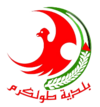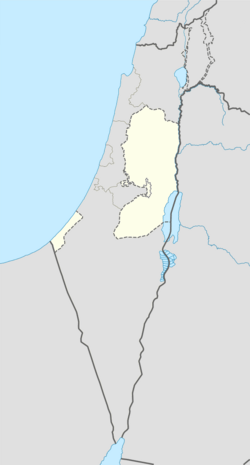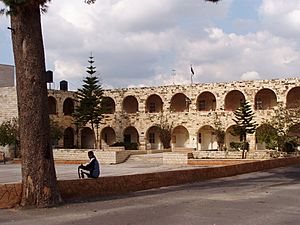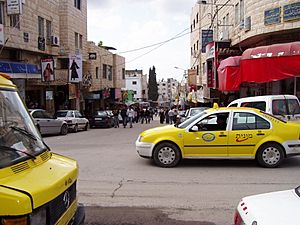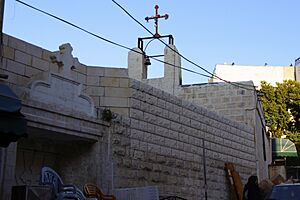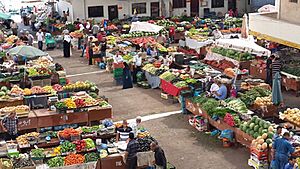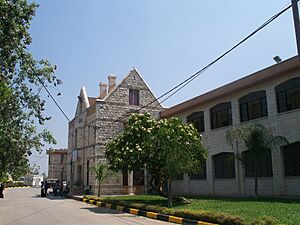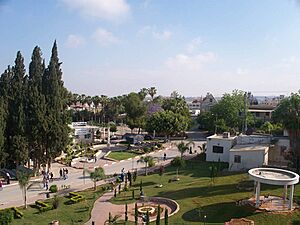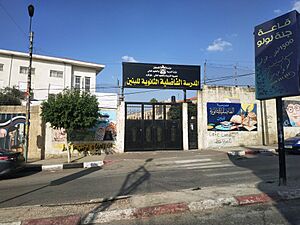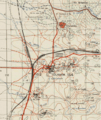Tulkarm facts for kids
Quick facts for kids
Tulkarm
|
||
|---|---|---|
|
Municipality type A (City)
|
||
| Arabic transcription(s) | ||
| • Arabic | طولكرم | |
| • Latin | Tulkarem (official) Tul Karem (unofficial) |
|
| Hebrew transcription(s) | ||
| • Hebrew | טולכרם | |
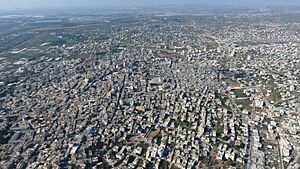
Tulkarm, 2020
|
||
|
||
| State | ||
| Governorate | Tulkarm | |
| Founded | Late 12th century | |
| Government | ||
| • Type | City | |
| Area | ||
| • Total | 28,793 dunams (28.8 km2 or 11.1 sq mi) | |
| Population
(2017)
|
||
| • Total | 64,532 | |
| • Density | 2,241/km2 (5,803/sq mi) | |
| Name meaning | The long (place) of the vineyard. | |
| Website | www.tulkarm.org | |
Tulkarm or Tulkarem is a Palestinian city. It is located in the West Bank region of Palestine. Tulkarm is the main city of the Tulkarm Governorate. To its west is the Israeli city of Netanya. To its east are Palestinian cities like Nablus and Jenin. In 2017, about 64,532 people lived in Tulkarm. The city is managed by the Palestinian National Authority.
Contents
What's in a Name?
The name Tulkarm comes from an old Aramaic word. That word was "Tur Karma." It means "mount of the vineyard." Later, the Arabic name for the city also meant "length of vineyard."
A Look Back in Time
Early History
After Muslims took control of Palestine in 1187, the first families came to Tulkarm. These families were from the Kurdish Zaydan clan. They were soldiers sent by Sultan Saladin to protect the area. The Zaydan family was very powerful in Tulkarm until the early 1600s.
Around 1230, Arab families from southern Palestine moved to Tulkarm. They were farmers and herders. The Fuqaha clan, who were religious scholars, were among these families.
During the Ayyubid and Mamluk periods, much of Tulkarm's land was set aside. It became a waqf, which is like a religious trust. This trust helped support an Islamic school in Jerusalem. In 1354, two-thirds of the village's farmlands were part of this trust. More Arab families came to Tulkarm from North Africa and Nablus during Mamluk rule. They mostly farmed and raised animals.
Ottoman Rule (1517-1918)
The Ottoman Empire took control of Tulkarm in 1517. Sultan Suleiman the Magnificent later changed the waqf to support another school in Jerusalem. Tulkarm's people paid a tax from their harvest to this trust. In 1548, the population grew to about 1,040 people.
By 1596, Tulkarm was the largest village in its area. It had about 968 Muslim residents. They paid taxes on crops, animals, and beehives. The town had five neighborhoods around the Old Mosque. Most people were Sunni Muslim farmers. Powerful families like the Zaydan and Tarabay ruled the area with much freedom. The Zaydan family collected taxes for the government.
In the mid-1600s, most of the Zaydan family were killed by the people of Tulkarm. This happened because the Zaydan family forced them to work too hard for taxes. After this, the Badran clan took political power. The Fuqaha family managed the waqf lands.
In 1799, a map made during Napoleon's invasion showed Tulkarm. It was called Toun Karin.
In 1858, new land laws were made. People had to register their land. Farmers were afraid of joining the army, so they let rich families register the land. This changed who owned the land in Tulkarm. The Samara, al-Hajj Ibrahim, and Hanun families gained large areas of land.
In the 1860s, a French explorer visited Tulkarm. He said it was a "considerable" size with about 1,000 people. The Ottoman government also gave the village farmland in the coastal plain.
In 1882, a survey described Tulkarm as a "long straggling village." It was on high ground, surrounded by farms and rocks. The houses were mainly made of stone.
Tulkarm became an important administrative center in 1876. It became a municipality in 1892. This made Tulkarm more important than nearby villages. The town center moved as new government buildings, a post office, a school, and a hospital were built.
Around 1900, the Hannun family owned many large farms in Tulkarm. They had strong ties with the local families.
In 1908, Tulkarm became a major train junction. It connected lines from Egypt to Haifa and Acre. It also connected to Jerusalem, Nablus, Ramallah, Lebanon, Syria, and Transjordan. During World War I, the Ottoman Army used Tulkarm as a main base. British planes bombed it. In 1918, British forces captured the city.
British Mandate Era (1920-1947)
The British government ruled Palestine after World War I. They made Tulkarm the center of its own subdistrict.
In 1920, a road was built to connect Tulkarm with Netanya on the coast. In 1945, a plan was made to help Tulkarm grow in an organized way. The city was divided into four main parts. Most businesses were along the main roads.
Tulkarm was a key place for Palestinian Arab rebels during the 1936–39 Arab revolt in Palestine. The leader of the revolt, Abd al-Rahim al-Hajj Muhammad, was from Dhinnaba, which is now part of Tulkarm.
In 1945, Tulkarm had 8,090 people. Most were Muslims, with some Christians and others. The city had a lot of farmland.
Jordanian Rule (1948-1967)
During the 1948 Arab–Israeli War, the Iraqi Army controlled Tulkarm. Later, Jordan took control of the West Bank, including Tulkarm. The agreements between Israel and Jordan in 1949 meant that much of Tulkarm's farmland became part of Israel. This caused many people to leave Tulkarm to find work. Tulkarm also received many Palestinian refugees. The city was cut off from nearby Arab towns. Its main connections were with Nablus.
In 1950, the Tulkarm Camp was built for refugees. It is now the second largest refugee camp in the West Bank. Tulkarm began to grow a lot after 1961. In 1963, the small village of Jarrad was added to the city. In 1964, Dhinnaba was added. In 1967, Shuweika and Irtah were also added.
Modern Times
Since the Six-Day War in 1967, Tulkarm has been under Israeli occupation. A military government ruled Tulkarm until 1982.
In 1995, control of Tulkarm was given to the Palestinian National Authority (PNA). This was part of the Oslo Accords peace agreements. During the early years of the Second Intifada, Israel briefly took control of Tulkarm again. In 2005, control was given back to the PNA. The PNA then limited weapons in the city.
On October 19, 2023, the Israeli army entered the city.
Where is Tulkarm?
Tulkarm is on the western edge of the northern West Bank. It is about 15 kilometers (9 miles) west of Nablus. It is also about 15 kilometers (9 miles) east of the Israeli city of Netanya. The city is near the 1948 ceasefire line.
Its location between a flat plain and mountains has made it important for trade and strategy. In the past, Tulkarm was a stop for caravans. It was also a trading center for goods from nearby villages. Armies also crossed through Tulkarm on their way to Egypt and the Levant.
Tulkarm is at the meeting point of three important old roads. One road goes north from the Latrun area along the coast. Another goes north along the hills. A third road goes from the Mediterranean Sea east to Nablus. In the past, it was also a junction for coastal and Hejaz railways.
Who Lives in Tulkarm?
| Year | Type | Population |
|---|---|---|
| 1548 | Census | 1,040 |
| 1596 | Census | 968 |
| 1860s | Estimate | 1,000 |
| 1922 | Census | 3,350 |
| 1931 | Census | 4,540 |
| 1945 | Census | 8,090 |
| 1961 | Census | 11,401 |
| 1967 | Census | 20,002 |
| 1997 | Census | 39,805 (with Camp) |
| 2007 | Census | 61,941 |
| 2017 | Census | 64,532 |
In 1922, about 3,350 people lived in Tulkarm. Most were Muslims, with some Christians and Jews. By 1931, the population grew to 4,827. In 1945, it was 8,090.
After the 1948 War, many Palestinian refugees came to Tulkarm. This caused the population to grow a lot. After the 1967 War, some people left for Jordan, so the population temporarily dropped. In 1967, the total population of Tulkarm and its nearby areas was 20,002. Most people were Muslims.
In 1997, Tulkarm city had 33,921 people. The Tulkarm Refugee Camp had 5,884 people. About 31.4% of the city's residents were refugees. More than half of the city's population (52.2%) was under 20 years old. By 2007, Tulkarm's population reached 51,300. The camp's population grew to 10,641.
Today, almost everyone in Tulkarm is Muslim. Before 1967, about 1,000 Christians lived there. Many left after the war. Now, only two Christian families remain. There is a Greek Orthodox church in the city. It was built in the early 1800s and is still active.
Weather in Tulkarm
Tulkarm has a Mediterranean climate. This means it has rainy winters and dry, hot summers. The average winter temperature is between 8 and 16 degrees Celsius (46-61 F). In summer, it's between 17 and 30 degrees Celsius (63-86 F). The sea breeze helps keep the climate mild. The average temperature in August is about 27 degrees Celsius (81 F). In February, it's about 13.5 degrees Celsius (56 F).
Humidity is moderate in summer, around 40-70%. It rises in winter to 70-85%. Tulkarm gets over 550 millimeters (21.6 inches) of rain each year. Most of the rain falls from December to February. July and August usually have no rain. The average yearly rainfall is 642 millimeters (25.3 inches).
| Climate data for Tulkarm | |||||||||||||
|---|---|---|---|---|---|---|---|---|---|---|---|---|---|
| Month | Jan | Feb | Mar | Apr | May | Jun | Jul | Aug | Sep | Oct | Nov | Dec | Year |
| Mean daily maximum °C (°F) | 17.0 (62.6) |
17.5 (63.5) |
19.6 (67.3) |
23.9 (75.0) |
24.2 (75.6) |
28.3 (82.9) |
29.0 (84.2) |
30.0 (86.0) |
27.9 (82.2) |
26.0 (78.8) |
23.0 (73.4) |
19.2 (66.6) |
22.76 (72.97) |
| Mean daily minimum °C (°F) | 8.9 (48.0) |
8.7 (47.7) |
10.5 (50.9) |
13.6 (56.5) |
17.2 (63.0) |
20.6 (69.1) |
23.0 (73.4) |
23.6 (74.5) |
20.7 (69.3) |
18.5 (65.3) |
14.1 (57.4) |
10.9 (51.6) |
15.54 (59.97) |
| Average precipitation mm (inches) | 124.9 (4.92) |
92.2 (3.63) |
52.8 (2.08) |
23.6 (0.93) |
2.7 (0.11) |
2.8 (0.11) |
2.2 (0.09) |
0.7 (0.03) |
1.2 (0.05) |
28.0 (1.10) |
77.4 (3.05) |
135.5 (5.33) |
538.3 (21.19) |
| Average precipitation days | 13.9 | 11.7 | 8.6 | 3.6 | 1.4 | 3.2 | 2.0 | 0.7 | 0.8 | 3.9 | 8.0 | 11.8 | 63.7 |
| Source: Israel Meteorological Service | |||||||||||||
Tulkarm's Economy
Before 1948, Tulkarm had a large farming industry. Grains, olives, and fruits like watermelons were the main crops.
Learning in Tulkarm
Palestinian Technical University - Kadoorie is the only government university in Palestine. It started as an agricultural college in Tulkarm in 1930. A Jewish giver named J.S. Kadoorie helped fund it. It became a university in 2007. Other places for higher learning include Al-Quds Open University and two campuses of An-Najah National University.
Tulkarm has seven high schools. Three are for girls: al-Adawiah, Jamal Abd al-Nasser, and Al-Khawaja. Three are for boys: al-Fadilia, Ihsan Samara, and Adnan Sefareni. There is also a vocational school for both boys and girls.
In 2016, a school in Tulkarm was named after Salah Khalaf. This was done to remember him as a "great national fighter."
Culture and Fun
The traditional clothes for women from Tulkarm were simple, dark dresses. They sometimes had embroidery. Today, embroidery is a main way for women in the city to earn money. Maps of historic Palestine are popular designs. The Palestinian dish musakhan is also popular in Tulkarm. The city shares many cultural traditions with nearby cities like Haifa and Nablus.
Tulkarm has an amusement park called Mega Land. Many thousands of people visit it during Muslim holidays.
Sports
Tulkarm has two semi-professional soccer teams. They are called Thaqafi Tulkarm and Markez Shabab Tulkarm. Both teams play in the Palestinian League Division One.
Famous People from Tulkarm
- Sanaa Alsarghali
- Abu Salma (1909–1980)
- Akram Al-Ashqar, film maker
- Ekrem Akurgal, Turkish archaeologist born in 1911 in Tulkarm
- Khaled Abu Toameh, Palestinian Israeli-Arab Muslim journalist
- Mar'i al-Karmi (1580–1624)
- Mahmoud Al-Karmi (1889–1939)
- Hasan Karmi (1905–2007)
- Abdul-Ghani Al-Karmi (1906–1974)
- Hilmi Hanoun (1913–2001), long-term mayor of Tulkarm
- Zuhair Al-Karmi (1921–2009)
- Ameen Nayfeh, film maker and writer
- Bassam Lotfi (1940-2022)
- Alaa Shreiteh (1979–2024)
Images for kids
See also
 In Spanish: Tulkarem para niños
In Spanish: Tulkarem para niños


